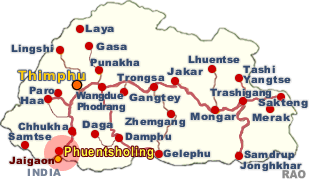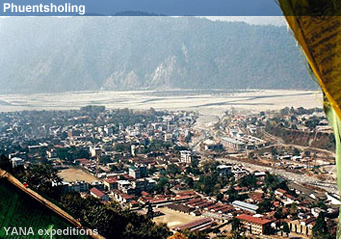 |
Bhutan's
Economy Phuentsholing |
|
 |
Bhutan's
Economy Phuentsholing |
|
|
 |
|
Phuentsholing and Jaigon (India)
|
 |
Once in its neighbour's shadow, Jaigaon has now eclipsed Phuentsholing
Save for a few new constructions, the country's main commercial hub, Phuentsholing still wears the look it did some decades ago.
In juxtaposition, its neighbouring Indian town of Jaigaon across the border continues to flourish.
An elderly Jaigaon merchant remembered how tiny his town was more than some 20 years ago.
"It was known as Chandkona then," he said. "It was mostly filled with makeshift huts, from which people sold vegetables and fruits."
Not anymore.
 |
|
From numerous hotels and restaurants to modern shopping malls, Jaigaon today has begun attracting more Bhutanese shoppers than ever before, with their display of a growing variety of fashionable garments, food and fancy gadgets that suit as varied a Bhutanese taste as one could find.
"It's now a hectic boomtown with business volumes soaring over millions of rupees," he said.
|
|
Elderly Phuentsholing town residents have witnessed the change, while remaining complacent about their stagnation. They said buildings mushroomed in the 1990's, followed by shopping complexes that sold imported garments, mainly from Thailand and China.
With expansive land, low labour and construction costs, and no municipal authority, Jaigaon expanded.
 |
|
Phuentsholing, on the other hand, was restricted by its limited land, municipality rules, prolonged construction procedures and high cost of construction.
"The only commercially viable businesses for Phuentsholing were bars, hotels, small retail shops and vegetable shops," said Phuentsholing thrompon Kuenzang Norbu.
According to the thrompon, high sales tax, compared with that of the bordering Indian town, worked against the Bhutanese businesses.
|
|
 |
|
"Businessmen cannot afford to sell it at low rates, unlike Jaigaon businessmen, who could afford to sell at cheaper rate because of low sales tax," he said.
This was one reason why Phuentsholing was experiencing an increase in the number of bars, vegetable shops and hotels.
Another way to keep business alive was by getting a wholesale business license, instead of retail shop license.
|
|
Selling goods at wholesale rate to smaller shops around the country was commercially viable.
Tshering Tenzin, a resident of Phuentsholing, said within last decade a lot of shops were sold along with the goods. "Shop owners were either unsatisfied or they failed to sustain," he said.
"The town is overshadowed by Jaigaon," said Tashi Wangmo, another resident.
With thousands of people from across the country choosing to shop in Jaigaon over Phuentsholing, it remains uncertain as to whether Phuentsholing really is the country's commercial hub.
Many Bhutanese are seen in Jaigaon as early as eight in the morning, and their shops are opening at about seven.
And the town offers a lot more compared to Phuentsholing. The cold may have pushed thousands from up north to Phuentsholing, but it may not be their only destination.
Apart from goods and commodities, Jaigaon also accommodates the Bhutanese in times of housing crunch.
| Contributed
by Dawa Gyelmo, KUENSEL, Bhutan's National newspaper, 2008 |
 |
top
| Information on Bhutan |
 |
|





